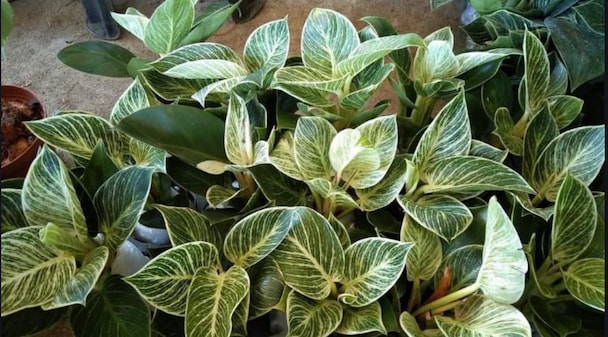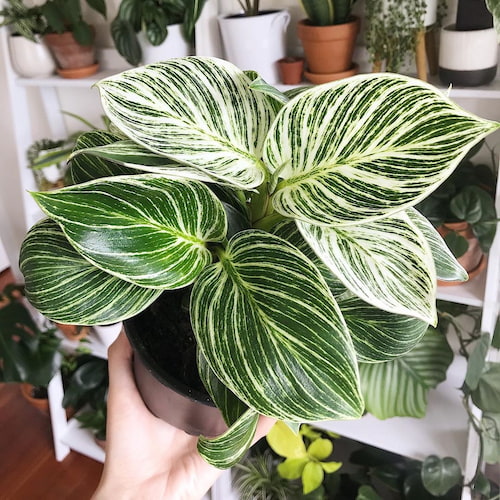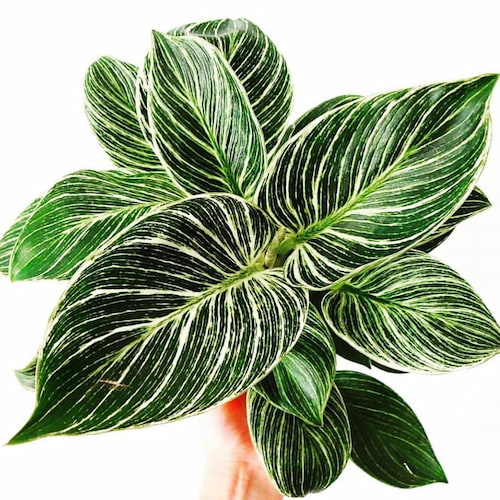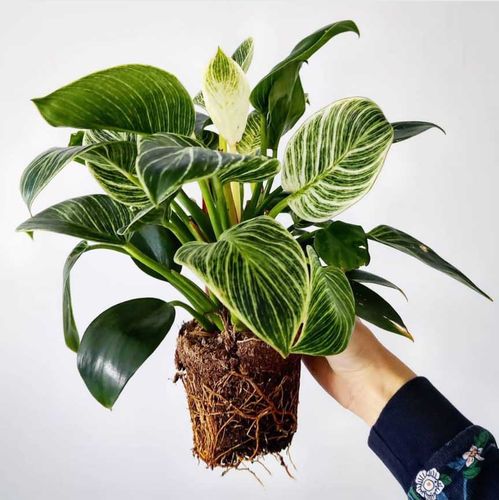Philodendron Birkin Care & Propagation Guide
Written by lisa
Dec 01 2022

Are you interested in purchasing a Philodendron Birkin or do you already own one? Here is a complete guide on taking good care of Philodendron Birkin plants.
Maintaining Philodendron Birkin in bright, indirect light is the most crucial aspect of care. Although direct sunlight can burn the leaves, keep it close to a window. Additionally, you ought to plant it in moist soil and allow it to dry out in between waterings.
Philodendron Birkin, a foliage plant, is native to South America and is a common perennial evergreen herb in tropical and subtropical regions. Philodendron Birkin is a unique and easy-care indoor plant with dark green leaves streaked with light yellow, and each leaf has a unique pattern. The lime-green stalks are thick and dense, which gives them a distinctive appearance and is very showy.Philodendron Birkin has strong vitality and can purify the air. It is suitable for homes, office buildings, hotels and other places. Philodendron Birkin likes warm and humid semi-shade environment, and is afraid of cold and strong light, which is suitable for growing in sandy loam rich in humus.

Cypress Vine Quick Info
| Botanical/Scientific Name | Philodendron Birkin, Philodendron White Wave |
| Common Name(s) | Philodendron Birkin, Birkins |
| Origin | South America |
| Growth Rate | Slowly |
| Light Care | Bright but avoid direct sun exposure |
| Soil Care | Rich in humus and well drained |
| Temperture Care | Ideal temperatures 20℃; Not lower than 10℃ |
| Humidty Care | High humidty - Ideal humidty 70% |
| Watering | Water before soil drying, keep slightly wet to dry |
| Pruning Care | Philodendron Birkin grows slowly, doesn’t need regularly pruning. |
| Fertilizer Care | 1 to 2 times a month, stop fertilizing in winter |
| Propagation | Cutting propagation, division propagation, sowing propagation |
Philodendron Birkin Care Key Points
Philodendron Birkin plant is a rare and easy-care houseplant, which is a great indoor plant for beginners. The following sections will provide an in-depth look into Philodendron Birkin care, propagation and other common problems. For your convenience, this article also lists the key information of philodendron birkin care briefly.Read More:
Is Philodendron Birkin Rare?
Philodendron Birkin Care
The leaves of Philodendron Birkin will gradually grow into an oval shape. The tip is slightly pointed and will be about 20 cm long. The appearance of leaf stripes of Philodendron Birkin is unstable. As the plant grows, one or several leaves may be pure green, and some may look like its parent plant Philodendron Rojo Congo. The currently known some leaves will become almost all white leaves or leaves with a little pink.The slow-growing nature of Philodendron Birkin also makes it a popular houseplant, because you can choose a nice pot for it and not have to worry about repotting it for at least a few years, and probably never.
Philodendron Birkin Soil Requirement
Philodendron Birkin grows best in a sandy loam rich in humus and well-drained. Potted Philodendron Birkin is often mixed with peat and perlite to prepare nutrient soil. (Read more about best soil for Philodendron Birkin.)Philodendron Birkin Temperature & Humidity Care
Philodendron Birkin needs to grow at a temperature of 20℃, not less than 10℃. Philodendron Birkin must be kept away from heating, air conditioning and cold wind to avoid excessive temperature fluctuations. Keep Philodendron Birkin indoors in winter. If the outdoor temperature is too low in winter, Philodendron Birkin can get frostbite. Philodendron Birkin is, after all, a tropical plant that likes warm, moist conditions. To grow in good condition, air humidity should be kept between 50-75%. If humidity is below 50%, Philodendron Birkin tends to appear yellow leaf and dry edges. It is often use these ways by spraying, sprinkling water to increase the humidity of the air. (Read More: 12 Popular Evergreen Plants with Pictures for Beginners)Beginners can use the following methods to increase humidity for Philodendron Birkin:
- Use a humidifier and spray gently around Philodendron Birkin leaves but not on the leaves.
- Pile plants that like high humidity together to form a slightly wet zone to maintain humidity, which is good for Philodendron Birkin growth
- DIY humidifier. Place a Philodendron Birkin pot on top of a shallow water tray filled with pebbles or other medium. Don't put the pot in the water; it will humidialize as the water evaporates
Philodendron Birkin Lighting
Philodendron Birkin is ideal for caring under bright scattered light. Do not keep Philodendron Birkin leaves in shade for a long time. Otherwise, Philodendron leaves tend to turn yellow. If you can find the right spot for this light, Philodendron Birkin leaves will have more pinstripes, especially on new leaves, and the pinstripes will gradually turn bright white. Adjust the location of Philodendron Birkin plants so that they are not directly exposed to strong light and can enjoy adequate sunlight in winter if you grow Philodendron Birkin indoors. Rotating Philodendron Birkin pot regularly allows it to grow more evenly with full exposure to light. (Read more about Philodendron Birkin Light Requirements.)Philodendron Birkin Watering
Watering is the most important step in caring for Philodendron Birkin. The soil must be kept moist (wetting means keeping the basin soil slightly wet) during spring and summer. In the fall and winter, water Philodendron Birkin when the soil is dry. Keep a permeable flowerpot and soil with your Birkins. Don't let water accumulate, as it may cause the Philodendron Birkin plant root rot. This can be done by inserting the finger into the basin about 5cm, which should be the length of the two joints of the finger. If it is already dry, it can be directly water through; Be careful only to water the soil and do not wet Philodendron Birkin leaves. Sometimes the soil is too dry and water can seep through quickly. The soil is not completely wet. Be patient and water the soil several times until it soaks. You can also use a dipping basin. (Read more about watering Philodendron Birkin.)- Always check the soil moisture level with your finger or a tool before watering. Don't water by feeling.
- Pay attention to the water temperature in winter, too cold is easy to frostbite Philodendron Birkin roots, which can be kept indoors for a day after warming up.
- Make sure you use a flowerpot that breathes well for Philodendron Birkin. Some flowerpots and containers don't have a drain hole under them.
- High humidity is not more watering, but to improve the humidity of the air.
- Make sure that Philodendron Birkin plants are in a well-ventilated environment. Good ventilation also affects the evaporation rate of water from pot soil.

Philodendron Birkin Fertilization
Fertilization of Philodendron Birkin should follow the principle of thin and frequent application of fertilizer, and nitrogen fertilizer should be the main fertilizer. Philodendron Birkin grows slowly at low temperatures, and fertilization may burn the root system, so it is better to stop fertilizer in winter. Over-Fertilization will also cause Philodendron Birkin's leaf to curl. (Read more about saving Philodendron Birkin leaves curling.)- If conditions suitable, Philodendron Birkin also grows year-round and can be fertilized when leaf growth is evident.
- If the new soil is used and the base fertilizer has been added, there is no need to add additional fertilizer.
- If the temperature and humidity are suitable, Philodendron Birkin still grows slowly and its leaves don't grow very large, whcih means lack of fertilizer.
- More fertilizer is not always better. Excessive fertilizer accumulation can damage Philodendron Birkin roots.
Philodendron Birkin Ventilation
Indoor Philodendron Birkin plant often appears red spider, scale insects and other pests, mostly due to lack of ventilation! This is one of the most overlooked things for beginners.- Due to poor ventilation and slow evaporation of water, philodendron birkin soil is prone to excessive wetting for a long time, resulting in the emergence of diseases and insect pests, and even root rot.
- Buy small fans to ventilate Philodendron Birkin plants. In winter, don't put them under Windows to blow cold air.
- If the environment is special and adequate ventilation is not available, you can compensate by reducing watering and placing Philodendron Birkin in a sunny environment. You can also adjust the soil distribution and choose a more permeable pot.
Philodendron Birkin Pest Control
Philodendron Birkin disease is mainly a physiological disease caused by improper care or environmental, which can be prevented by good care measures. Spraying carbendazim and chlorothalonil to prevent Philodendron Birkin disease. The main pest of Philodendron Birkin is red spider, which is usually caused by dry air. It can be effectively prevented by spraying water frequently and wiping the leaves. When there is pest, special insecticide should be sprayed for control.
Philodendron Birkin Propagation
The propagation of Philodendron Birkin are cutting, sowing and dividing. It is better to adopt cutting and dividing method for propagating philodendron birkin at home, and the operation is relatively simple. philodendron birkin cutting propagation is appropriate in early summer. Cut the stems of Philodendron Birkin, which grow well and have long branches, and insert them directly into clean river sand and place them in half shade. Keep high air humidity and temperature at about 25℃, and it will take root in 20-25 days. When Philodendron Birkin grows small plants at the base, it can be combined with soil change and pot change. Small plants can be carefully separated from the old Philodendron Birkin plants, so as not to hurt the old plants and the roots. It can also pick the side plant in advance, which can dwarf the plant and give birth to more side plants. When the new side plant has about 15 centimeters, cut off the root with air and plant another. (Find more best indoor hanging plants here.)Philodendron Birkin FAQs
Is Philodendron Birkin Toxic?
Philodendron Birkin is a poisonous plant. Its leaf juice, roots and leaves are poisonous. Accidentally touching or ingesting its juice can cause pharynx and mouth discomfort, serious suffocation, resulting in heart paralysis, and even death. Skin contact with the SAP can cause itching or intense irritation, and eye contact with the SAP can cause severe conjunctivitis and blindness. If your family has kids or pets, it is not recommended to grow Philodendron Birkin. (Read more about Philodendron Birkin's toxicity.)Does Philodendron Birkin Need Regular Pruning?
Since Philodendron Birkin grows slowly, it doesn't need to be pruned very often, just by removing the old yellow leaves.What if Philodendron Birkin Leaves Turn Yellow
1. When growing philodendron Birkin, air humidity should be kept between 50-75%. When the humidity is below 50%, Philodendron Birkin tends to appear yellow leaves.2. Philodendron Birkin should not be placed in a shady environment for a long time, otherwise the leaves will easily turn yellow.
Read More:
How To Save My Philodendron Birkin Yellow Leaves?
How Big Does a Philodendron Birkin Get?
Although most Birkins I've seen in stores are 6 to 12 inches tall, they can initially be quite small. Your Birkin will most likely reach a height of one to a few feet when grown indoors.
A larger surface area may be required due to the plant's ability to grow both up and out.
Do Philodendron Birkins Climb?
Although they don't necessarily climb, birkins do rise from the plant's center. They occasionally get a little heavy and sag. the point at which mine began to sag. To help support it, I planted a bamboo stake in the ground. Unlike some other philodendrons, birkins don't have vines.
Can My Philodendron Birkin Plant Hurt My Cat?
All philodendrons, regrettably, do contain calcium oxalate crystals, which are poisonous when consumed. both for humans and for animals. The best course of action is to keep this plant away from children, pets, and especially cats.
Where Can I Find a Philodendron Birkin?
They were very difficult to find when I first got my Birkin. I bought mine at a nearby nursery for about $50. They are currently available in Walmarts for about $15, which is funny. However, it's alright because now more people can enjoy them! I still cherish mine.
Birkins are a Trending Tropical that Costa Farms mass produces, and as a result, they are becoming more and more commonplace wherever Costa Farms supplies plants. Thus, there will be many more Walmarts, Lowe's, Home Depots, and similar stores. Be vigilant and seize that Birkin!
Latest Updated
- Benefits of Bugleweed - 7 Science-backed Health Benefits
- Bugleweed Dangers & Side Effects - Is It Poisonous?
- How to Plant Evergreen Trees - What You Should Know
- When to Plant Evergreens - Grow Guide for Evergreen Trees
- 12 Wonderful Evergreen Shrubs for Your Garden
- 12 Popular Evergreen Plants with Pictures for Beginners
- When And How To Prune A Lilac Bush Like a Pro
- How to Grow & Care for Lilac Vine (Hardenbergia Violacea)
- Japanese Lilac Tree (Syringa Reticulata) Care & Propagation Guide
- Shumard Oak Pros and Cons - What to Know
Popular Articles
- Winter maintenance of Antirrhinum Majus
- How to Grow Terminalia Mantaly Tree
- How to Grow and Care for Crossostephium Chinense
- How to grow Antirrhinum Majus in spring
- Peristeria Elata (Dove Orchid) Profile: Info & Care Guide
- Underwatered Snake Plant (Sansevieria Trifasciata) - Signs And How To Fix
- How to Care for Brazilian Jasmine Plant (Mandevilla Sanderi)
- How to Grow & Care for Graptopetalum Purple Delight in Summer
- Rosa Chinensis (China Rose): Plant Growing & Care Tips
- How to Care for Baby Sun Rose (Aptenia Cordifolia)